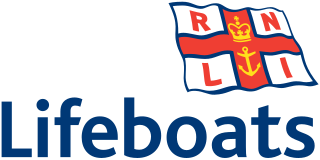
The Royal National Lifeboat Institution (RNLI) is the largest of the lifeboat services operating around the coasts of the United Kingdom, the Republic of Ireland, the Channel Islands, and the Isle of Man, as well as on some inland waterways.
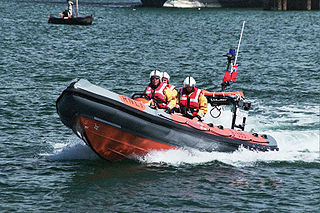
A rigid inflatable boat (RIB), also rigid-hull inflatable boat or rigid-hulled inflatable boat (RHIB), is a lightweight but high-performance and high-capacity boat constructed with a rigid hull bottom joined to side-forming air tubes that are inflated with air to a high pressure so as to give the sides resilient rigidity along the boat's topsides. The design is stable, light, fast and seaworthy. The inflated collar acts as a life jacket, ensuring that the vessel retains its buoyancy, even if the boat is taking on water. The RIB is an evolutionary development of the inflatable boat with a rubberized fabric bottom that is stiffened with flat boards within the collar to form the deck or floor of the boat.
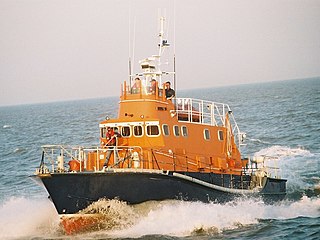
The Arun-class lifeboat was a fast all-weather lifeboat designed by the Royal National Lifeboat Institution (RNLI) for service at its stations around the coasts of the United Kingdom and Ireland. They were operated by the RNLI between 1971 and 2008. Many have been sold to see further service in the lifeboat and coastguard services of other countries.

The Severn class is the largest lifeboat operated by the Royal National Lifeboat Institution (RNLI). The class, which is 17.3 metres long, was introduced in to service in 1996. It is named after the River Severn, the longest river in Great Britain. The lifeboats are stationed at 35 locations around the coasts of the United Kingdom and Ireland and can provide coverage up to 125 nmi (232 km) out to sea.

Mersey-class lifeboats are All-weather lifeboats operated by the Royal National Lifeboat Institution (RNLI) from stations around the coasts of Great Britain and Ireland, with three former RNLI boats operated by ADES Uruguay, and one by Bote Salvavidas de Valparaiso, Chile. They are capable of operating at up to 17 knots (31 km/h) and can be launched from a carriage or by slipway.
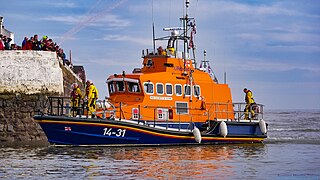
The Trent-class lifeboat is an all-weather lifeboat operated by the Royal National Lifeboat Institution (RNLI) from 30 stations around the coasts of Great Britain and Ireland to provide coverage up to 50 miles (80 km) out to sea. Introduced to service in 1994, the class is named after the River Trent, the second longest river wholly in England.

Tamar-class lifeboats are all-weather lifeboats (ALBs) operated by the Royal National Lifeboat Institution (RNLI) around the coasts of Great Britain and Ireland. They have replaced the majority of the older Tyne ALBs. The prototype was built in 2000 and 27 production boats were constructed between 2006 and 2013.

The E-class lifeboat forms part of the RNLI fleet in the United Kingdom, operating exclusively in the tidal reach of the River Thames in London. The class was introduced in 2002 to serve the tidal reach of the River Thames, which had not previously been covered by an RNLI rescue service, as a result of a much delayed enquiry into the Marchioness disaster in 1989, in which 51 people died. The enquiry criticised the lack of a rescue service for the tidal Thames, and the UK government asked the Maritime and Coastguard Agency, the Port of London Authority and the RNLI to work together to set up a dedicated Search and Rescue service for this stretch of the river.

The Shannon-class lifeboat is the latest class of lifeboat currently being deployed to the RNLI fleet to serve the shores of the British Isles. The Shannon class is due to replace most Mersey-class lifeboats and some Trent-class lifeboats.
Since its inception, the Royal National Lifeboat Institution (RNLI) has provided lifeboats to lifeboat stations in the United Kingdom and Ireland.
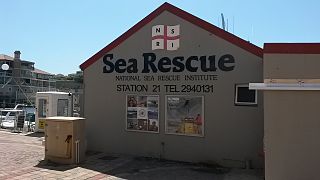
The National Sea Rescue Institute (NSRI) is a voluntary non-profit organisation in South Africa tasked with saving lives through drowning prevention. It operates 49 bases comprising coastal stations, inland stations on dams, auxiliary stations and lifeguard units. There are crews on standby at all hours. There are over 1000 volunteers equipped with sponsored rescue craft, rescue vehicles, quad bikes and tractors, supported by an operations department at the head office.

The Oakley-class lifeboat refers to two types of self-righting lifeboat operated by the Royal National Lifeboat Institution (RNLI) around the coast of the United Kingdom and Ireland between 1958 and 1993. The 37-foot (11.3 m) Oakley was designed for carriage launching, while the larger 48-foot-6-inch (14.8 m) version was designed for slipway launching or to lie afloat. During their service they saved a combined total of 1,456 lives in 3,734 rescue launches.

Fowey Lifeboat Station is the base for Royal National Lifeboat Institution (RNLI) search and rescue operations at Fowey on the south coast of Cornwall in the United Kingdom. The first lifeboat was stationed in the area in 1859 and the present station was opened in 1997. It operates a Trent Class all weather boat (AWB) and a D class (IB1) inshore lifeboat (ILB).

The Waveney-class lifeboat was the first class of lifeboats operated by the Royal National Lifeboat Institution (RNLI) capable of operating at speeds in excess of 10 knots (12 mph). Based on an American design, 22 saw operational service between 1964 and 1999 at the RNLI's stations around the coast of the United Kingdom and Ireland. After being superseded by faster boats in the 1990s, many were sold for further use with lifeboat services abroad, notably in Australia and New Zealand.
The Thames-class lifeboat was operated by the Royal National Lifeboat Institution (RNLI) from its stations around the coasts of the United Kingdom between 1974 and 1997. Six were ordered but only two completed; they have both been sold on to other users.

The Rother-class lifeboat was a self-righting lifeboat operated by the Royal National Lifeboat Institution around the coast of the United Kingdom and Ireland between 1972 and 1995. They were based on the 37 ft (11 m) Oakley-class lifeboat.
The Solent-class lifeboat is a steel-hulled version of the 48-foot-6-inch (14.78 m) Oakley-class self-righting lifeboat and is sometimes referred to as the 48-foot, 6-inch Oakley-class Mark III. Solent Operational Numbers followed on from the first three 48-foot, 6-inch Oakleys and were interrupted by the last two Oakleys. The operational numbers of the Solent-class had three digits in the suffix to indicate a metal hull. Two digits indicates a wooden, glass-reinforced plastic or fiber-reinforced composite hull.

Calshot Lifeboat Station is located on Calshot Spit near the village of Calshot, Hampshire, and is on the southern bank of the open end of Southampton Water, on the south coast of England. The station is owned and operated by the Royal National Lifeboat Institution (RNLI) and operates two inshore lifeboats: an B-class and a D-class (IB1).

The 42ft Watson-class was a class of non self-righting displacement hull lifeboat built between 1954 and 1962 and operated by the Royal National Lifeboat Institution (RNLI) around the coasts of the United Kingdom and Ireland between 1954 and 1987.

Plymouth Lifeboat Station is the base for Royal National Lifeboat Institution (RNLI) search and rescue operations at Plymouth in England. The first lifeboat was stationed in the city in the early 1800s. The station moved to its present site at Millbay Docks in 1992, a Grade II-listed three-storey tower. Since 2003 it has operated a Severn-class all-weather boat (ALB) along with an B-class Atlantic inshore lifeboat (ILB).

















